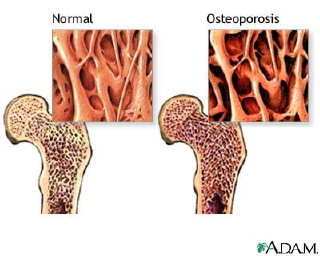Under Construction 
 Osteoporosis is reduced Bone Mineral Density (BMD), particularly in post-menopausal women, but it can occur in men and younger women.
Osteoporosis is reduced Bone Mineral Density (BMD), particularly in post-menopausal women, but it can occur in men and younger women.
It is caused by more bone cells being resorbed than being deposited. This imbalance results in a progressive loss of bone density and a thinning of bone tissue.
Researchers estimate that about 1 out of 5 American women over the age of 50 have osteoporosis. About half of all women over the age of 50 will have a fracture of the hip, wrist, or vertebra (bones of the spine).
Prevention:
The risk of Osteoporosis can be reduced with hormone replacement therapy, supplements e.g. Calcium and Vitamin D and other medication (see below).
Exercise with weights can help improve bone density and avoid Osteoporosis.
Treatment:
Estrogen therapy / hormone therapy: These are therapies only for women that consist of estrogen alone or estrogen combined with progestin.
Selective Estrogen Receptor Modulators (SERMs): These medications interact with estrogen receptors, providing a protective effect on bone.
Medications to treat osteoporosis fall into two main categories: antiresorptives and anabolics.
Antiresorptives slow loss of Bone Mineral Density (BMD). Antiresorptive medications include alendronate (brand name Fosamax®), risedronate (brand name Actonel®) and zoledronic acid (brand name Reclast®). These medications are in a class of drugs called bisphosphonates.
Anabolics speed up bone formation. Teriparatide (brand name Forteo®), was the first to be approved.
Calcitonin: This is a hormone that helps regulate calcium and bone processes.
Links:
Osteoporosis at National Osteoporosis Foundation (NOF.org)
U.S. National Library of Medicine (www.nlm.nih.gov)
Osteoporosis Treatment Options - Strong to the Bone
Back Pain - Symptoms - Cause - Remedy
Return to health
last updated 23 Aug 2009
|  Health
Health
 Osteoporosis
Osteoporosis
 Health
Health
 Osteoporosis
Osteoporosis
